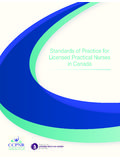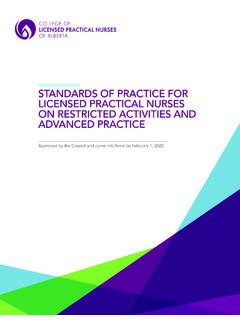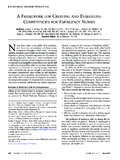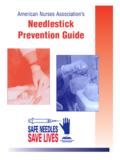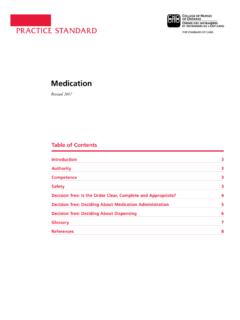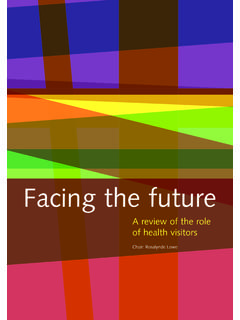Transcription of Code of Ethics for Licensed Practical Nurses in Canada
1 Code of Ethics for Licensed Practical Nursesin CanadaForewordThe Canadian Council for Practical nurse Regulators (CCPNR) is a federation of provincial and territorial members who are identified in legislation, and responsible for the safety of the public through the regulation of Licensed Practical Nurses (LPNs).The Council of the CCPNR recognized the need for a single code of Ethics across member jurisdictions to articulate the ethical values and responsibilities that LPNs uphold and promote, and to which they are accountable. The code of Ethics guides LPNs ethical reflections and decision-making across all areas of LPN practice, and informs the public about the ethical values and responsibilities of the LPN profession and conveys the profession s commitment to society.
2 This document also serves as a guide for curriculum development and for public and employer awareness of the practice expectations of the Licensed Practical nurse . A steering committee from the representatives of all jurisdictions who license and/or regulate LPNs across Canada (with the exception of Quebec) was identified to guide and advise the project. One World Inc. was commissioned to research and develop the code of Ethics in collaboration with the steering committee. This document was validated by the LPN community and key stakeholder groups across Canada and was approved by the Boards of the respective regulatory authorities of the CCPNR s Board members. The CCPNR thanks all participants who contributed to the creation of this CCPNR approves and adopts the code of Ethics for LPNs outlined in this opinions and interpretations in this publication are those of the author and do not necessarily reflect those of the Government of in French under the title: Code de d ontologie des infirmiers et infirmi res auxiliaires autoris (e)s au CanadaThis project is funded in part by the Government of Canada s Foreign Credential Recognition 2013 CCPNRAll rights reserved.
3 The reproduction, storage in a retrieval system or transmission in any form or by any means (including electronic, mechanical, photographic, photocopying or recording) of any part of this publication without the prior written permission from CCPNR (Canadian Council for Practical nurse Regulators) is an infringement of copyright information contact CCPNR:Telephone: | Fax: | Email: | Website: Code of Ethics articulates the ethical values and responsibilities that Licensed Practical Nurses (LPNs)1 uphold and promote, and to which they are accountable. The Code serves to: guide LPNs ethical reflections and decision-making across all areas of Licensed Practical nurse practice; and, inform the public about the ethical values and responsibilities of the LPN profession and convey the profession s commitment to primary responsibility is to the client within the context of an inter-professional collaborative environment.
4 Client refers to an individual (or their designated representative(s), families, and groups).Respect for the inherent dignity and rights of clients, colleagues and LPNs underpins the five ethical principles encompassed in the Code. These principles although distinct are inter-related and include: 1. Responsibility to the Public 2. Responsibility to Clients 3. Responsibility to the Profession 4. Responsibility to Colleagues 5. Responsibility to OneselfLPNs use the Code of Ethics in conjunction with professional standards and competencies, workplace policies, and legal requirements that guide their practice and behaviour. In achieving these requirements, they fulfill their contract with society for ethical Principles and Ethical Responsibilities are described on the following pages.
5 The Principles are statements of the five ethical principles to which LPNs are held accountable. The Ethical Responsibilities that accompany each Principle are inter-related and are statements of expected professional conduct in LPN practice situations. The Principles and Ethical Responsibilities are not in any order of priority collectively they reflect the LPNs overall commitment to society. Appendix A provides Guidelines for Ethical Decision-making. 1 For the purposes of this document, the term Licensed Practical nurse also refers to registered Practical nurse . PRINCIPLE 1: Responsibility to the PublicLicensed Practical Nurses , as self-regulating professionals, commit to provide safe, effective, compassionate and ethical care to members of the Responsibilities:LPNs: Maintain standards of practice, professional competence and conduct.
6 Provide only those functions for which they are qualified by education or experience. Demonstrate an understanding that community, society and the environment are important factors in the health of individual clients. Respect the rights of all individuals regardless of their diverse values, beliefs and cultures. Provide care directed toward the health and well-being of the person, family, and community. Collaborate2 with clients, their families (to the extent appropriate to the client s right to confidentiality), and health care colleagues to promote the health and well-being of individuals, families and the public. 42 Collaborate is defined as to work in partnership with members of the interdisciplinary health care team while maintaining autonomy, within one s own scope of practice.
7 PRINCIPLE 2: Responsibility to ClientsLicensed Practical Nurses provide safe and competent care for their Responsibilities:LPNs: Respect the right and responsibility of clients to be informed and make decisions about their health care. Respect and support client choices. Assist and support client participation in making decisions about their health and well- being when factors reduce their capacity for making decisions, in accordance with applicable legislation and regulation. Respect and adhere to the jurisdictional legislation on capacity assessment and substitute decision-making when the client is incapable of consent. Consider with other health care professionals and substitute decision-makers the best interests of the client and any previously known wishes or advanced directives that apply in situations where the client is incapable of consent.
8 Advocate for the client to receive fair and equitable access to needed and reasonably available health services and resources. Respect and protect client privacy and hold in confidence information disclosed except in certain narrowly defined exceptions. Safeguard health and personal information by collecting, storing, using and disclosing it in compliance with relevant legislation and employer policies. Report any situation where private or confidential information is accessed or disclosed without appropriate consent or legal authority, whether deliberately or through error. Ensure that any discussion/communication (verbal, written or electronic) is respectful and does not identify the client unless appropriate.
9 Maintain professional boundaries in the use of electronic media. Act promptly and appropriately in response to harmful conditions and situations, including disclosing safety issues to appropriate authorities. Report to appropriate authorities and take other action in a timely manner to ensure a client s safety and quality of care when unethical or incompetent care is Provide care to each client recognizing their individuality and their right to choice. Develop trusting, therapeutic relationships, while maintaining professional boundaries. Use evidence and judgement to guide nursing decisions. Identify and minimize risks to clients.
10 Apply new knowledge, technology and scientific advances to promote safety, client satisfaction and Applicable legislation and employer policies should also be consulted to determine in what circumstances reporting is 3: Responsibility to the ProfessionLicensed Practical Nurses have a commitment to their profession and foster the respect and trust of their clients, health care colleagues and the Responsibilities:LPNs: Maintain the standards of the profession and conduct themselves in a manner that upholds the integrity of the profession. Participate in activities allowing the profession to evolve to meet emerging healthcare needs. Practise in a manner that is consistent with the privilege and responsibility of self-regulation.
